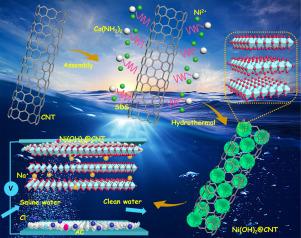高性能Ni(OH)2@CNT异质结对电容去离子脱盐效果的协同效应
IF 9.8
1区 工程技术
Q1 ENGINEERING, CHEMICAL
引用次数: 0
摘要
电容去离子(CDI)技术具有操作简单、运行成本低、环境可持续性和低功耗等优点,是一种很有前途的水处理技术。然而,CDI系统的性能主要受到所使用电极性能的限制。为了提高传统碳基材料的离子吸附能力和能量利用效率,开发先进的电极材料至关重要。在本研究中,采用简单的溶剂热法成功合成了由Ni(OH)2纳米片和碳纳米管(Ni(OH)2@CNT)组成的异质结结构。电化学表征证实了Ni(OH)2@CNT杂化材料具有优异的电容性Na+存储性能、快速的Na+离子扩散动力学和长期充放电循环稳定性。复合电极与活性炭复合制备CDI器件,在工作电压为1.2 V的500 mg/L NaCl溶液中,其吸附容量为43 mg/g,充电效率为90.2%。此外,该电极还具有良好的能量利用效率和再生循环稳定性。通过对Na+吸附机理的研究,确定了Na+离子的高效去除是Ni(OH)2与CNT的协同作用的结果,包括Ni(OH)2的插层吸附和CNT的双电层吸附。本研究开发的高性能Ni(OH)2@CNT异质结为推进电容式海水淡化技术提供了一个有前途的技术解决方案。本文章由计算机程序翻译,如有差异,请以英文原文为准。

Synergistic effects in high-performance Ni(OH)2@CNT heterojunction for improved salt removal in capacitive deionization
Capacitive deionization (CDI) is a promising water treatment technology that offers several advantages, including simple operation, low operational cost, environmental sustainability, and low power consumption. However, the performance of CDI systems is primarily constrained by the properties of the electrodes used. To improve the ion adsorption capacity and energy utilization efficiency of conventional carbon-based materials, the development of advanced electrode materials is of critical importance. In this study, a heterojunction structure composed of Ni(OH)2 nanosheets and carbon nanotubes (Ni(OH)2@CNT) was successfully synthesized using a straightforward solvothermal method. Electrochemical characterization confirmed that the Ni(OH)2@CNT hybrid exhibited excellent capacitive Na+ storage performance, rapid Na+ ion diffusion kinetics, and long-term charge-discharge cycling stability. When combined with activated carbon to fabricate a CDI device, the composite electrode achieved a high adsorption capacity of 43 mg/g and a charge efficiency of 90.2 % in a 500 mg/L NaCl solution under a working voltage of 1.2 V. Moreover, the electrode demonstrated superior energy utilization efficiency and regeneration cycling stability. Through investigation of the Na+ adsorption mechanism, it was determined that the efficient removal of Na+ ions resulted from the synergistic effect between Ni(OH)2 and CNT, involving intercalation adsorption by Ni(OH)2 and electric double-layer adsorption by CNT. The high-performance Ni(OH)2@CNT heterojunction developed in this study offers a promising technical solution for advancing capacitive desalination technology.
求助全文
通过发布文献求助,成功后即可免费获取论文全文。
去求助
来源期刊

Desalination
工程技术-工程:化工
CiteScore
14.60
自引率
20.20%
发文量
619
审稿时长
41 days
期刊介绍:
Desalination is a scholarly journal that focuses on the field of desalination materials, processes, and associated technologies. It encompasses a wide range of disciplines and aims to publish exceptional papers in this area.
The journal invites submissions that explicitly revolve around water desalting and its applications to various sources such as seawater, groundwater, and wastewater. It particularly encourages research on diverse desalination methods including thermal, membrane, sorption, and hybrid processes.
By providing a platform for innovative studies, Desalination aims to advance the understanding and development of desalination technologies, promoting sustainable solutions for water scarcity challenges.
 求助内容:
求助内容: 应助结果提醒方式:
应助结果提醒方式:


